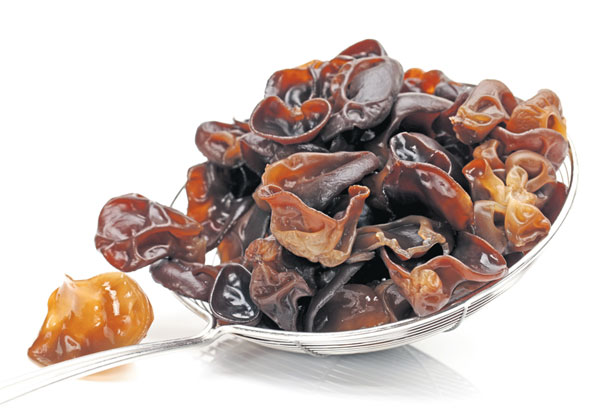Black is beautiful

Editor's Note: China is divided into as many culinary regions as there are different ethnic groups. Its geographical diversity and kaleidoscopic cultural profiles contribute to the unending banquet of flavors.
They are wrinkled, sometimes slightly slimy, and it's hard to imagine them on the dinner table. This is the black jelly fungus, beloved all over China and an essential Chinese culinary basic.
In the West, it is known as wood ear, jelly ear or by its long scientific description of Auricularia auriculajudae, a name derived from the belief that Judas Iscariot hanged himself from an elder tree, from which these ear-shaped fungi sprouted.
The Chinese generally have no hang ups about Judas, and the black wood-ear fungus is enjoyed in stir-fries, soups and, in the northern regions, in cold-tossed dishes.

| Heimu'eri s used for brightness and crunch for the famous Luohan Vegetables. Photos Provided to China Daily |
It is mostly a texture food, appreciated for its tactile crunch and crispness. Its flavor, slightly musky, is often masked by the other ingredients it is cooked with.
For the Chinese, heimu'er is also valued for its curative properties, and it is cooked in soups to cut cholesterol levels, lower blood sugar and control hypertension.
The fungus is most commonly sold dried, hardened into scrunched up morsels which are then soaked and rehydrated before cooking. Fresh wood-ears are now available in markets in the south but are definitely less popular due to their slimy jellylike feel.
There are several varieties, with colors ranging from a pale chocolate to deep black, and sizes vary as well.
Large wood-ear mushrooms, white and furry on the underside, are more valued for their medicinal properties. They are simply boiled and drunk as an infusion or slow-cooked in soups. Furry wood-ears are slightly leathery and not as tasty as their smaller cousins.
The more petite species is smooth and dark on both sides, and once rehydrated, it resumes its bright glossiness and an attractive translucency. They are slightly sweet, smooth and crunchy.
Nutrition-wise, black jelly fungus is rich in protein, with traces of potassium and selenium, and just a little fat.
In traditional Chinese medicine, heimu'er promotes healthy bowels, clears the lungs and is used as an anti-coagulant. For that reason, its popularity in the large cities, especially, has grown in tandem with the number of smoggy days.
The best black wood-ears in China are produced in the relatively remote northern province of Heilongjiang, along the Xiaoxing'an Ridge. Here, cool wooded areas provide the jelly fungus with clean air, unpolluted water and ideal growing conditions.
In the past, wood-ear growing was mostly a cottage industry, but it has seen a production surge in recent years.
Black wood-ear from Heilongjiang is dried, tightly compressed and then vacuum-packed into compact little boxes. Online shopping and convenient courier services have made these once-inaccessible points of sale popular.
Still, domestic consumption is so high that demand far exceeds supply and China imports dried wood-ears mainly from Australia, with some from Vietnam and Malaysia.
The larger, leathery fungus is produced locally in the warmer coastal cities in the south, such as Fujian, Guangdong and Guangxi. Yunnan also grows some.
The most interesting question is: How do Chinese cooks prepare this strange ingredient? Let's walk our way through the culinary map.
On the island of Hainan, the famous East Mountain goat meat is cooked in a herbal stew that features the black wood-ear. The mutton is braised in clay pots with dried bean curd sticks, various Chinese herbs such as astralagus, angelica root and licorice bark, and plenty of black wood-ear.
During the long cooking process, the fungus soaks up the meaty flavors and becomes delicious, and through some culinary alchemy it also takes away the pungency of the goat.
Across on the mainland, the Cantonese in Guangdong and Guangxi love using the wood-ear in stirfries that feature meat or are vegetarian.
On Buddhist festivals, temple cooks use wood-ear and other mushrooms to create flavor contrasts in the famous Luohan Vegetables, a very colorful dish. The wood-ear is used for its brightness and its crunch.
The Cantonese also like the wood-ear in their favorite steamed dishes. A classic example is chicken with black wood-ears, seasoned with nothing more than salt and pepper, which allows the jelly fungus to soak up the chicken flavors while the dish steams.
Farther inland, in Sichuan, heimu'er is a crucial ingredient in the signature hot and sour soup, suanla tang. Again, the wood-ear stands out from among the bamboo shoots, tofu and shredded pork with its well-defined crunch.
Throughout China, black woodears are an accent in stir-fries, but it is in the cold-tossed salads of the north that they take on a leading role.
Whole fungi are rehydrated and blanched before being tossed in a vinegar dressing. This is an important visually appealing appetizer that is almost always served before a major meal, both at home and in restaurants.
paulined@chinadaily.com.cn
Some classic recipes
Cold-tossed Heimu'er
20-25 pieces of black wood-ears, soaked
2-3 fresh red bird's eye chili
Chopped coriander leaves
2-3 cloves garlic, minced
3-4 tablespoons black vinegar
1 tablespoon soy sauce
1 tablespoon sugar
Sesame oil
Rinse the black wood-ears and trim off any hard ends. Blanch them in boiling water for about 5 minutes. Drain well and cut into bite-sized segments.
Mix together vinegar, sugar and soy sauce. Taste to adjust seasoning. Mix in a spoonful of sesame oil and add garlic and chopped chili. Mix to emulsify the dressing.
Pour the dressing over the wood-ears and toss to coat thoroughly. Garnish with coriander and serve chilled.
Cantonese Steamed Chicken with Wood-ear
Two whole chicken legs, about 500-600g
5-6 pieces dried wood-ear, soaked
1-2 water chestnuts, peeled and sliced
1 teaspoon cornstarch
1 tablespoon oyster sauce
Salt and pepper
Sesame oil
Chop the chicken into bite-sized pieces and marinate with cornstarch, oyster sauce, salt and pepper. Set aside.
Trim rehydrated wood-ears, removing hard stem ends. Cut into smaller segments.
Fold the wood-ears and water chestnuts into the chicken mixture and place into a deep dish that can go onto the steamer. Steam over high heat for 15 minutes. Finish with a little sesame oil.
Vegetarian Stir-fry
200g cauliflower
1/2 small carrot
100g sugar snap peas
5-6 pieces wood-ears, soaked
Salt and pepper
Pinch of sugar
Cut cauliflower into florets and blanch quickly. Drain.
Slice carrot thinly on the diagonal.
Trim wood-ears and cut into smaller pieces.
Top and tail peas.
Heat up oil in wok and add cauliflower, carrots, wood-ears and peas, stir-frying over high heat. Season to taste. Adding a pinch of sugar will accentuate the sweetness of the vegetables. Add a splash of water and give the vegetables a final toss. Serve hot.
(China Daily Africa Weekly 04/21/2017 page19)
Today's Top News
- Germany vows to tackle people-trafficking to the UK
- Greek farmers fear fresh US tariff blow
- Global banks, institutions optimistic on China growth
- Chinese people's heroic victory praised
- Sichuan's ethnic festival attracts thousands of tourists
- Goal of high-tech self-reliance unchanged: China Daily editorial































